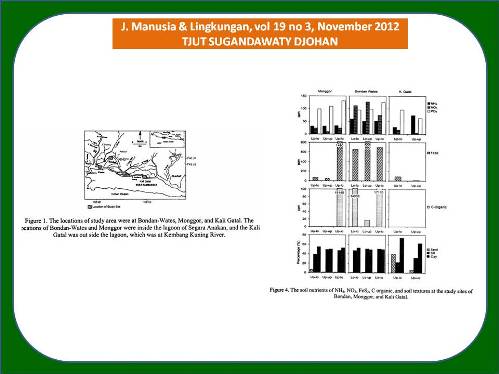
DISTRIBUTION AND ABUNDANCE OF MANGROVE VEGETATION IN THE DISTURBED ECOSYSTEM OF SEGARA ANAKAN, CENTRAL JAVA (Distribusi dan Kemelimpahan Vegetasi Bakau di Ekosistem Hutan Rusak Segara Anakan Jawa Tengah)
Tjut Sugandawaty Djohan(1*)
(1) Laboratory of Ecology and Conservation Faculty of Biology Gadjah Mada University,Yogyakarta 55281
(*) Corresponding Author
Abstract
ABSTRACT
The Segara Anakan mangrove from 1980 up to the present has experienced heavy siltations and mangrove-tree cutting. The siltation of 4.5 million tons per year from the watershed of Citanduy River create a lot of newly formed land and shoals, which disturbed the pattern of tidal flow and tide periods. In 1997 large areas of mangroves were converted to shrimp ponds which failed and were abandon. The purpose of this research was to study the response of mangrove vegetation to the changing of the Segara Anakan ecosystem. This study compared the area which experienced only heavy siltation and tree cutting with the area experienced only tree cutting. The transect methods with quadrate plots were used in collecting data. The results showed that there were 16 species of mangrove and one aquatic macrophyte. Almost all of the areas were colonized by the shrub, Acanthus ilicifolius, and liana-shrub, Derris heterophylla. Both of these species had r and k strategies, which had coverage almost 100%, and had consecutive 83583 and 23938 densities shrubs per ha. The dominant tree species were Sonneratia alba with 485 trees per hectare and Avicennia alba with 203 trees per hectare. However, the distribution and abundance of mangrove trees were determined by the tree cutting activities, and they were not determined by the high siltation rate and salinity. The combination between heavy siltation, mangrove tree cutting, land clearing and the climate change worsen the Segara Anakan mangrove ecosystem. Therefore, the mangrove of Segara Anakan was a critically endangered ecosystem.
ABSTRAK
Hutan bakau Segara Anakan sejak tahun 1980 sampai sekarang mengalami siltasi yang sangat tinggi dan penebangan pohon bakau. Setiap tahunnya menerima 4,5 juta ton sedimen dari daerah tangkapan air Citanduy, dan mengakibatkan terbentuknya pulau-pulau baru dan dangkalan di lagunanya. Keadaan ini telah mengganggu pola arus dan pasang surut. Pada tahun 1997, hutan bakau tersebut dalam skala luas telah diubah jadi tambak udang, akan tetapi tidak berhasil dan ditinggalkan sebagai tambak rusak. Tujuan penelitian ini mempelajari respon vegetasi hutan bakau terhadap perubahan ekosistem Segara Anakan, dengan membandingkan lokasi hutan bakau yang megalami silatasi berat dan penebangan pohon bakau dengan lokasi yang hanya ditebang pohon bakaunya saja. Metode yang digunakan adalah kuadrat plot dengan bantllan garis transek. Hasil menunjukkan bahwa ada 16jenis mangrove dan satu akuatik makrophyta. Hampir seluruh hutan bakau dikoloni oleh semak dan liana bakau, Acanthus ilicifolius, dan Derris heterophylla dengan penutup hampir 100%. Densitasnya berurutan adalah 83583 and 23938 per ha. Ke dua spesies tersebut bersifat r dan K strategi. Pohon dominan Sonneratia alba adalah 485 per ha, dan Avicennia alba with 203. Distribusi spesies pohon bakau ditentukan oleh aktivitas penebangan pohon, bukan oleh sedimentasi dan salinitas. Kombinasi antara silatasi yang tinggi, penebangan pohon bakau, dan perubahan iklim telah memperburuk kondisi hutan bakau, sehingga hutan bakau Segara Anakan dapat dikategorikan sebagai ekosistem terancam kritis.
Keywords
Full Text:
Artikel lengkap (PDF) (Bahasa Indonesia)Article Metrics
Refbacks
- There are currently no refbacks.
Copyright (c) 2017 Jurnal Manusia dan Lingkungan







